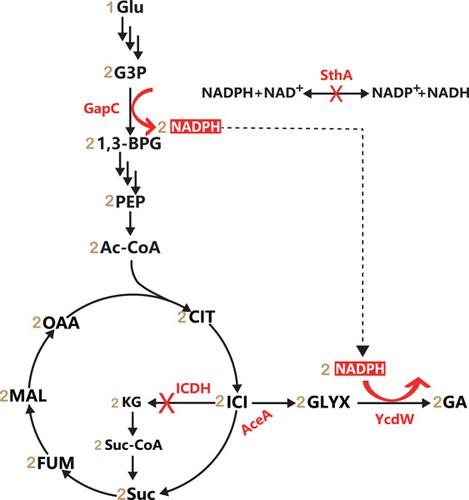当前位置:
X-MOL 学术
›
Biotechnol. Bioeng.
›
论文详情
Our official English website, www.x-mol.net, welcomes your feedback! (Note: you will need to create a separate account there.)
Multiple strategies for metabolic engineering of Escherichia coli for efficient production of glycolate
Biotechnology and Bioengineering ( IF 3.8 ) Pub Date : 2021-09-07 , DOI: 10.1002/bit.27934 Tong Zhu 1, 2, 3 , Die Yao 2, 3, 4 , Di Li 1, 2, 3 , Hongtao Xu 2, 3 , Shiru Jia 1 , Changhao Bi 2, 4 , Jun Cai 4 , Xinna Zhu 2, 3 , Xueli Zhang 2, 3
Biotechnology and Bioengineering ( IF 3.8 ) Pub Date : 2021-09-07 , DOI: 10.1002/bit.27934 Tong Zhu 1, 2, 3 , Die Yao 2, 3, 4 , Di Li 1, 2, 3 , Hongtao Xu 2, 3 , Shiru Jia 1 , Changhao Bi 2, 4 , Jun Cai 4 , Xinna Zhu 2, 3 , Xueli Zhang 2, 3
Affiliation

|
Glycolate is a bulk chemical with wide applications in the textile, food processing, and pharmaceutical industries. Glycolate can be produced from glucose via the glycolysis and glyoxylate shunt pathways, followed by reduction to glycolate. However, two problems limit the productivity and yield of glycolate when using glucose as the sole carbon source. The first is a cofactor imbalance in the production of glycolate from glucose via the glycolysis pathway, since NADPH is required for glycolate production, while glycolysis generates NADH. To rectify this imbalance, the NADP+-dependent glyceraldehyde 3-phosphate dehydrogenase GapC from Clostridium acetobutylicum was introduced to generate NADPH instead of NADH in the oxidation of glyceraldehyde 3-phosphate during glycolysis. The soluble transhydrogenase SthA was further eliminated to conserve NADPH by blocking its conversion into NADH. The second problem is an unfavorable carbon flux distribution between the tricarboxylic acid cycle and the glyoxylate shunt. To solve this problem, isocitrate dehydrogenase (ICDH) was eliminated to increase the carbon flux of glyoxylate and thereby improve the glycolate titer. After engineering through the integration of gapC, combined with the inactivation of ICDH, SthA, and by-product pathways, as well as the upregulation of the two key enzymes isocitrate lyase (encoding by aceA), and glyoxylate reductase (encoding by ycdW), the glycolate titer increased to 5.3 g/L with a yield of 1.89 mol/mol glucose. Moreover, an optimized fed-batch fermentation reached a titer of 41 g/L with a yield of 1.87 mol/mol glucose after 60 h.
中文翻译:

大肠杆菌代谢工程高效生产乙醇酸的多种策略
乙醇酸盐是一种大宗化学品,广泛应用于纺织、食品加工和制药行业。乙醇酸可通过糖酵解和乙醛酸分流途径从葡萄糖产生,然后还原为乙醇酸。然而,当使用葡萄糖作为唯一碳源时,有两个问题限制了乙醇酸盐的产率和产率。首先是通过糖酵解途径从葡萄糖产生乙醇酸的辅因子失衡,因为乙醇酸生产需要NADPH,而糖酵解产生NADH。为了纠正这种不平衡,来自丙酮丁醇梭菌的 NADP +依赖性甘油醛 3-磷酸脱氢酶 GapC被引入以在糖酵解过程中甘油醛 3-磷酸的氧化中生成 NADPH 而不是 NADH。可溶性转氢酶 SthA 被进一步消除以通过阻止其转化为 NADH 来保存 NADPH。第二个问题是三羧酸循环和乙醛酸分流之间的不利碳通量分布。为了解决这个问题,异柠檬酸脱氢酶(ICDH)被淘汰,以增加乙醛酸的碳通量,从而提高乙醇酸的滴度。通过整合gapC进行工程改造后,结合 ICDH、SthA 和副产物途径的失活,以及两种关键酶异柠檬酸裂合酶(由aceA编码)和乙醛酸还原酶(由ycdW编码)的上调),乙醇酸滴度增加到 5.3 g/L,产率为 1.89 mol/mol 葡萄糖。此外,优化的补料分批发酵在 60 小时后达到 41 g/L 的滴度,产率为 1.87 mol/mol 葡萄糖。
更新日期:2021-11-16
中文翻译:

大肠杆菌代谢工程高效生产乙醇酸的多种策略
乙醇酸盐是一种大宗化学品,广泛应用于纺织、食品加工和制药行业。乙醇酸可通过糖酵解和乙醛酸分流途径从葡萄糖产生,然后还原为乙醇酸。然而,当使用葡萄糖作为唯一碳源时,有两个问题限制了乙醇酸盐的产率和产率。首先是通过糖酵解途径从葡萄糖产生乙醇酸的辅因子失衡,因为乙醇酸生产需要NADPH,而糖酵解产生NADH。为了纠正这种不平衡,来自丙酮丁醇梭菌的 NADP +依赖性甘油醛 3-磷酸脱氢酶 GapC被引入以在糖酵解过程中甘油醛 3-磷酸的氧化中生成 NADPH 而不是 NADH。可溶性转氢酶 SthA 被进一步消除以通过阻止其转化为 NADH 来保存 NADPH。第二个问题是三羧酸循环和乙醛酸分流之间的不利碳通量分布。为了解决这个问题,异柠檬酸脱氢酶(ICDH)被淘汰,以增加乙醛酸的碳通量,从而提高乙醇酸的滴度。通过整合gapC进行工程改造后,结合 ICDH、SthA 和副产物途径的失活,以及两种关键酶异柠檬酸裂合酶(由aceA编码)和乙醛酸还原酶(由ycdW编码)的上调),乙醇酸滴度增加到 5.3 g/L,产率为 1.89 mol/mol 葡萄糖。此外,优化的补料分批发酵在 60 小时后达到 41 g/L 的滴度,产率为 1.87 mol/mol 葡萄糖。


























 京公网安备 11010802027423号
京公网安备 11010802027423号